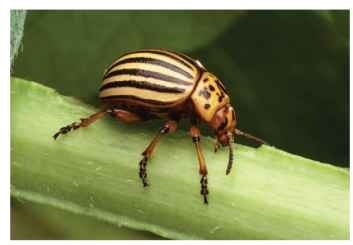The Colorado potato beetle, Leptinotarsa decemlineata (Coleoptera: Chrysomelidae), is the most devastating, defoliating, insect pest of potato (Solanum tuberosum). Uncontrolled, it is capable of causing complete crop failure. The potato beetle is important because of the damage it causes to potato and some related crops, as well as its extraordinary ability to evolve resistance to insecticides used in its control.
GEOGRAPHICAL SPREAD AND HOST RANGE
A native of Mexico, the Colorado potato beetle was first recorded in the United States in 1811, feeding on a native plant, buffalo bur (Solanum rostratum} near the Iowa-Nebraska border. It was first reported as a pest on potato in Nebraska in 1859. The expansion of its host range to include potato allowed the beetle to spread rapidly eastward, moving among farm and garden plantings. By 1874, it had spread to the East Coast of the United States. The potato beetle now occurs in North America throughout Mexico, the United States, and Canada, except California, Nevada, and the coastal area of the Pacific Northwest, between 15 and 55°N latitude. It was accidentally introduced into France in 1922 and subsequently spread throughout Europe (except Great Britain) and the former Soviet Union; it now occurs in China, Greece, Turkey, and northern Iran.
The host range of the Colorado potato beetle is largely restricted to plants in the genus Solanum. Although geographically restricted populations vary in their ability to utilize particular plant species as hosts, potato is the preferred host for most populations.
LIFE HISTORY AND CROP INJURY
Colorado potato beetles overwinter as adults in the soil within potato fields and field margins. There are typically one to three generations per year, depending on latitude and the availability of host plants. Adult Colorado potato beetles are oval and approximately 9.5mm in length and 6.4mm in width. They are yellow-orange with 10 narrow, black longitudinal stripes on their elytra (Fig. 1). Adults typically consume 130-1200 mm2 of foliage per day and are highly fecund, depositing up to 3000 yellow eggs in clusters of 10-50 eggs on the lower surface of host leaves over a period of several weeks. All larvae within an egg mass hatch simultaneously, typically within 4-14 days, depending on temperature. Larvae have a distinctive ” hunchbacked” appearance, a black head capsule, and two rows of black spots on each side of the body. Instars 1 and 2 are brick red, whereas instars 3 and 4 are pink to salmon. The larvae are voracious feeders, with fourth instars consuming as much as 500 mm2 of potato foliage per day. Larval development requires as little as 8 days or as long as 28 days at average temperatures of 29°C and 14°C, respectively.

FIGURE 1 Adult female Colorado potato beetle on potato.
Mature fourth instars burrow into the soil where they pupate. The pupal stage typically lasts 8-18 days, depending on temperature.
The Colorado potato beetle is primarily a pest of potatoes, but may also damage tomato (Solanum esculentum) and eggplant (S. melongena). In potato, yield reductions are related to both the amount of defoliation and the stage of plant growth during which it occurs. Yield reductions in tomato and eggplant result from feeding injury to the fruits as well as from defoliation.
MANAGEMENT
Although a number of cultural measures, including crop rotation, isolation from previous potato crops, planting early maturing potato varieties, and use of trap crops, were recommended for potato beetle control, hand removal of adults, eggs, and larvae from infested plants was the primary means of control prior to the introduction of the insecticide Paris Green (copper acetoarsenite) in the late 1800s. Arsenic-based insecticides remained the primary means of control until dichloro-diphenyl-trichloroethane (DDT) replaced them in the late 1940s. Resistance of the Colorado potato beetle to DDT was first reported in New York in the early 1950s. Resistance to other chlorinated hydrocarbon insecticides soon followed throughout much of the potato-growing region of the eastern United States. A series of insecticides was used to control the beetle during the succeeding decades and the potato beetle developed resistance to each. By the early 1980s, insecticide resistance had reached a crisis level. In many locations potato beetle populations could not be controlled using insecticides. This stimulated a burst of research activity, which resulted in development of more holistic pest management approaches. These involved foliar applications of the bacterial pathogen Bacillus thuringiensis subsp. tenebrionis, crop rotation, naturally occurring biological control, scouting and the use of economic thresholds, and the use of narrow-spectrum insecticides. Since the mid-1990s, several new, narrow-spectrum insecticides have become available to control resistant potato beetle populations. Currently potato beetle management relies on these new insecticides used within a pest management context to minimize selection for insecticide resistance and negative environmental impacts. Despite this emphasis, potato beetle populations have developed resistance to some of the more widely used insecticides that first became available during the mid-1990s. These populations remain susceptible to more recently introduced insecticides that have different modes of action.
In 1995, transgenic potato varieties that expressed the Cry 3A protein from B. thuringiensis subsp. tenebrionis, which is highly toxic to the Colorado potato beetle, were registered for use in the USA. These varieties were very effective in controlling the potato beetle. At their peak, they were grown on approximately 20,000 hectares before being withdrawn from the market in 2001 in response to resistance from export markets in Europe and Japan and concerns about consumer resistance to food products containing genetically engineered potatoes. Over time, it is likely that these concerns will diminish and transgenic potatoes will become an important tool for managing Colorado potato beetle.
